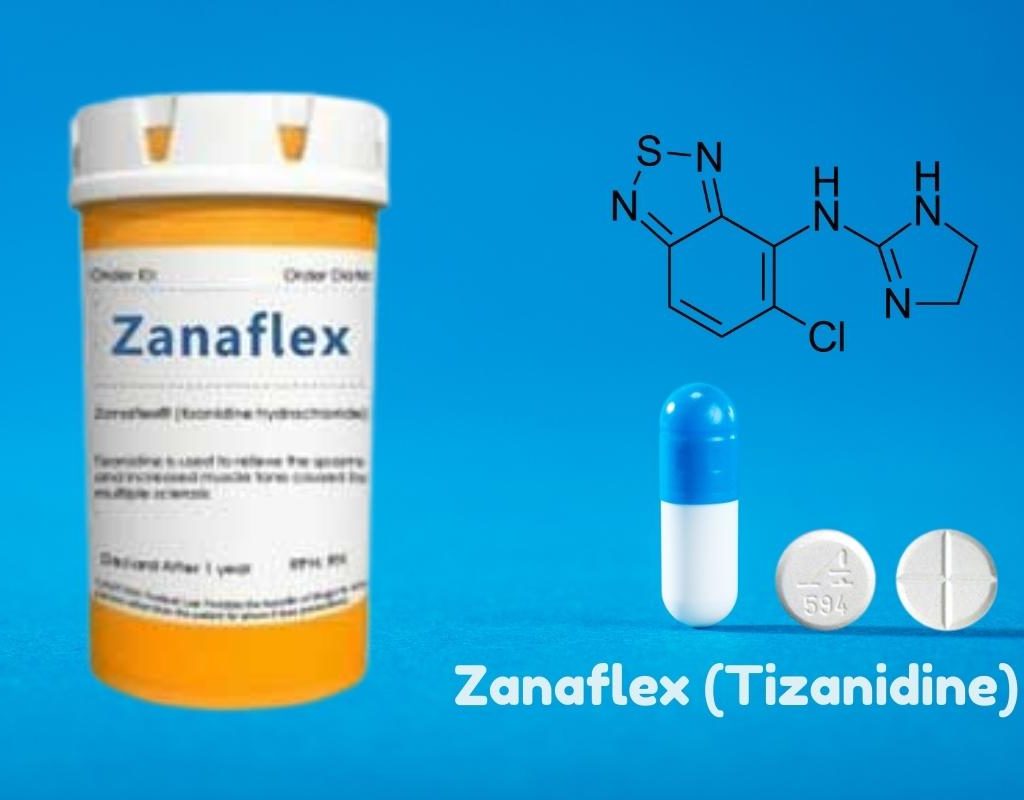Overview:
Zanaflex is a prescribed medicine that is used to treat symptoms of stiffness of muscles (spasticity) that is caused by ailments like Cerebral palsy, or other neurological conditions.
It is a medication that can be used by itself or in conjunction with other medications.
Zanaflex (Tizanidine) is a group of drugs that are also known as Central Alpha-2-Adrenergic Agonists.
It is not clear whether Zanaflex is safe and effective for children.
What are the possible adverse consequences of Zanaflex?
Zanaflex can have serious side effects, including:
- Lower blood pressure
- Atypical liver function test results,
- Drowsiness,
- Hallucinations,
- Excessive drowsiness,
- Slow heart rate,
- Dry mouth,
- Fatigue, and Weaknesses
Take immediate medical assistance If you experience some of the signs mentioned in the above list.
The most common side effects of Zanaflex are:
- Dry mouth
- Tiredness
- Weakness
- Fatigue
- Tiredness
- Dizziness
- Urinary tract infection
- Constipation
- A typical liver function test
- Vomiting
- Speech disorder
- Lazy eye (amblyopia)
- Urinary frequency
- Influenza symptoms
- Uncontrolled muscle movements
- Nervousness,
- Sore throat sore throat, and
- Runny nose
Contact your doctor if are experiencing any adverse reaction that is bothersome to you or persists.
Several side effects could be triggered by Zanaflex. For more details, consult your physician or pharmacist.
Symptoms of an allergic reaction may include rash, itching, swelling, dizziness, or difficulty breathing. If you develop any of these symptoms after taking Zanaflex, seek immediate medical attention. It is crucial to inform your healthcare provider about any known allergies or previous adverse reactions to medications to ensure the safe use of Zanaflex.
Contact your physician for advice from a medical professional regarding possible side effects. You can report adverse reactions to the FDA at 1-800-FDA-1088.
DESCRIPTION:

Zanaflex(r) (tizanidine hydrochloride) is an alpha2-adrenergic central agonist. Tizanidine HCl is a white to off-white fine crystalline powder that has no odor or a faintly distinctive odor.
Tizanidine is somewhat soluble in water and methanol. Its solubility in water decreases as pH rises.
Its chemical name is 5-chloro-4-(2- imidazolin-2-ylamino)-2,1,3-benzothiadiazole monohydrochloride.
INDICATIONS:
Zanaflex is recommended for the treatment of spasticity. Due to the brief duration of the therapeutic effect treatment with Zanaflex, it should be reserved for regular activities, and at times when relief from spasticity is the most.
Dosing Information:
Zanaflex Capsules(r) and Zanaflex(r) tablets can be prescribed either with or without food. Once the formula is chosen and the decision to use it in combination with or without meals is taken, the prescribed regimen must not be changed. It is best to take them with food to reduce the chance of side effects. If you take them without food, monitor for side effects such as lightheadedness and dizziness. You should also take them at the same time each day.
Foods can have complex effects on the pharmacokinetics of tizanidine, which are different with different formulations.
Zanaflex Capsules along with Zanaflex tablets have bioequivalence in the conditions of fasting (more than three hours following eating) but not under the conditions of feeding (within 30 minutes of having a meal).
Therefore, the doctor should be acquainted with modifications in the kinetics of the drug that occur in these circumstances. The recommended dose for starting of 2 mg.
Since the effects of Zanaflex peak around 2 to 1 hour post-dose and diminish between 3 and six hours after dose the treatment can be repeated between 6 and 8-hour intervals according to the need, up with a maximum of 3 doses within 24 hours.
Dosage may be increased gradually from 2 to 4 mg per dose, and with one to four days between dose increases until a satisfactory reduction in the muscle tone has been achieved.
The daily dosage must not be more than 36 milligrams. Doses that are greater than 16 mg haven’t been investigated.
Dosing In Patients With Renal Impairment:
For patients suffering from impaired renal function, Zanaflex must be cautiously used because creatinine clearance of less than 25ml/min decreased by 50% in these types of patients when every dose should be decreased.
Dosing In Patients with Hepatic Impairment:
Zanaflex is to be taken with caution in patients who have any type of hepatic impairment. For those patients, when titrating the doses for each patient should be decreased.
If more doses are required the individual doses instead of the frequency of doses are recommended to be increased.
The monitoring of aminotransferase levels is advised for the initial period and one month after the maximum dose has been attained, or when hepatic damage is suspected.
Drug Discontinuation:
If the therapy has to be stopped, in particular for patients being treated with high dosages (20 mg to 36 mg per day) for extended durations (9 months or longer) or receiving concurrent treatment with narcotics.
The dose is recommended to be reduced slowly (2 up to 4 mg daily) to limit the risk of withdrawal as well as Tachycardia, rebound hypertension, or hypertonia.
Dosage Forms & Strengths:
Capsules:
The capsules come in a 2 mg light blue body color with a light blue opaque cap and 2 Mg is printed on it another higher dosage comes in 4 mg with a white opaque body with a blue opaque cap color that has “4 MG” printed on the cap 6 mg Blue opaque body covered with a white stripe, and blue opaque cap that has “6 MG” printed on the cap
Tablets:
4 mg white tablets that are uncoated and without coating. A quadrisecting scoring scores on one of the sides, and embossed in “A594” on the other side.
Storage & Handling:
Zanaflex Capsules:
Zanaflex Capsules capsules are available in 3 strengths, the capsules that contain Tizanidine Hydrochloride 2.29 mg. 4.58 mg, and 6.87 mg, which equals 2 mg 4 mg, and 6 mg of tizanidine base.
Two mg pills come with an opaque light blue body, with caps that are light blue that has “2 MG” printed on the cap 150 capsules in bottles (NDC 70515-602-15)
Keep the product at 25 degC (77degF) Excessive excursions are allowed between 15degC and 30degC (59degF between 86°F and 59°C) (see USP for Controlled Room Temperature[see USP Controlled Room Temperature].
Use containers with a children-proof closure.
ZANAFLEX SIDE EFFECTS:
The adverse reactions listed below are described elsewhere in the other sections of the prescribing information
- Hypotension
- Liver Injury
- Sedation
- Hallucinosis/Psychotic-Like Symptoms
- Hypersensitivity Reactions
Clinical Trials Experience:
Since clinical trials are conducted under various conditions, the rates of adverse reactions found in the clinical trials of a particular drug can’t be directly compared with rates in clinical studies of a different drug.
It is possible that they do not be representative of the rates seen in the clinical setting.
WARNINGS & PRECAUTIONS
Hypotension:

Tizanidine is an A2-adrenergic receptor that can cause hypotension. Syncope is reported in post-marketing settings.
The possibility of severe hypotension could be decreased by titrating the dose, and by paying close attention to the signs and symptoms of hypotension before increasing.
Additionally, patients who move from a supine posture to a standing upright may be more susceptible to orthostatic and hypotension-related effects.
Risk of Liver Injury:
Zanaflex may cause hepatocellular liver injury.
The monitoring of aminotransferase levels is suggested at the time of baseline and one month after the maximum dose has been reached, or if liver injury is suspected.
Sedation:
Zanaflex can induce sedation that can interfere with daily routine.
In studies with multiple doses the proportion of patients experiencing sedation peaks within the first week of titration but continues to be stable throughout the time of study maintenance.
Hallucinosis/Psychotic-Like Symptoms:
Zanaflex usage has been linked with hallucinations.
Visual hallucinations that are fabricated or delusions have been observed in 5 out of 170 patients (3 percent) during the two North American controlled clinical studies.
The majority of patients knew that the experiences were not real. One patient suffered from psychosis as a result of the hallucinations.
Withdrawal Adverse Reactions:
Rebound hypertension, tachycardia, or hypertonia.
To reduce the chance of developing these reactions, especially in patients who are taking high dosages (20 or more than 28 mg per day) for prolonged durations (9 days or more) or receiving concurrent treatment with narcotics and/or narcotics, the dosage is recommended to be reduced slowly (2 up to four mg daily)
ZANAFLEX OVERDOSE:
A study of the database of safety monitoring showed cases of accidental and deliberate Zanaflex overdoses.
A few of these cases ended in death and most of the accidental overdoses included multiple drugs, which included CNS depressants.
In the majority of cases, sensors were less sensitive to light observed, which included lethargy, confusion, somnolence, and coma.
The depressed function of the heart is also evident, most commonly hypotension and bradycardia.
Respiratory depression is another frequent characteristic of tizanidine overdose.
If an overdose occurs, the basic measures to ensure the integrity of the airway and monitoring of respiratory and cardiovascular systems must be carried out.
So, dialysis is not likely to be an effective method for removing drugs from the bloodstream.
The majority of symptoms will disappear within a period of one to three days after the discontinuation of tizanidine, and the application of the appropriate treatment.
Conclusion:
From the US –
You can consult your doctor for any type of medical advice regarding the side effects and you may also report it to FDA at 1-800-FDA-1088 or www.fda.gov/medwatch.
This blog on Zanaflex (Tizanidine) is only made for knowledge of various Side effects, Warnings, and precautions so, better to consult a qualified doctor before using this medicine.
Read more articles on different types of medicine by subscribing to us. Feel free to leave a comment below.


